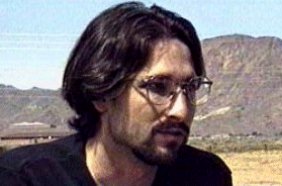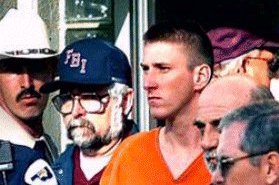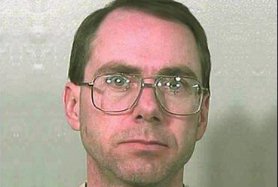Note: The three conspirators profiled below are the only ones charged in connection with the Oklahoma City bombing. Other persons, however, such as members of the white supremacist Aryan Republican Army in Elohim City, Oklahoma, have been linked to McVeigh's activities. A 2001 FBI report indicated that McVeigh had connections with the Aryan Republican Army and participated with their members in bank robberies. Several witnesses also have identified ARA member Michael Brescia as "John Doe No. 2," who was said to be with McVeigh in Kansas just days before the Murrah Building was bombed. Other ARA members, according to several published reports, also assisted McVeigh in Kansas in April 1995. McVeigh, however, denied that the Elohim City gang had anything to do with the bombing--but the results of a polygraph test taken by McVeigh suggests that he might have been lying about this to protect others.
 Michael Fortier
BORN: 1968
Sentenced to 12 years in prison on May 27, 1998.
Released on January 26, 2006 after serving 10+years.
|
 Timothy J. McVeigh
BORN: 4/23/1968
On June 13, 1997, jury sentenced to death.
Executed on June 11, 2001.
|
 Terry Nichols
BORN: 4/1/1955
On June 4, 1998, sentenced to life in prison.
Serving sentence in federal prison in Florence, Colo.
|
|
Biography Michael Joseph Fortier was born in Maine in 1968, then moved with his family to Kingman, Arizona at age seven. After graduating from Kingman High, Fortier entered the army, where he met Timothy McVeigh at Fort Benning, Georgia in 1988. The company, which also included Terry Nichols, moved on to Fort Riley, Kansas, where Fortier served until his honorable discharge in May 1991. Fortier shared a common interests with his friends McVeigh and Nichols. All considered themselves marksmen and all had contempt for the federal government. At McVeigh's urging, Fortier read The Turner Diaries, a book seen as inciting violent action against an overreaching federal government. After his stint in the service, Fortier returned to Kingman where he enrolled in Mohave Community College and worked part-time in a printing shop and a hardware store. He was known locally for his participation in gun control protests. On July 25, 1994, Fortier married his high school sweetheart, Lori, in a Las Vegas casino. McVeigh was his best man. At the time of McVeigh's trial in 1997, the couple had two children, a four-year-old daughter and a one-year-old son. The Fortiers hosted McVeigh at their Kingman mobile home several times from 1993 to early 1995. Outside the home, Fortier flew a flag depicting a coiled snake and bearing the words, "DON'T TREAD ON ME." Fortier, a heavy drug user, introduced McVeigh to marijuana and crystal meth. The two would share stories on drug highs as they laid on their backs and gazed into the night sky. On other occasions, they vented their anger about gun control, "the New World Order," or the ambitious plans of the United Nations. In the Arizona desert, McVeigh proudly detonated his increasingly sophisticated homemade bombs for the entertainment of the Fortiers. In the Fortier's living room in October 1995, McVeigh laid out his plans to bomb "a federal building in Oklahoma City." He drew a diagram showing how he planned to put together his bomb. Later, when McVeigh tried to recruit Fortier to aid in mixing the bomb's components or help station a getaway car, Fortier refused. After the April 19, 1995, explosion, Fortier lied to FBI investigators, telling them he knew nothing about the bombing. He told friends, however, that he hoped to get "a cool mil" selling book and movie rights to his story and, that if ever called to testify in the case, "I will...pick my nose...and wipe it on the judge's desk." Within weeks, his tune changed. Fortier pled guilty and testified in criminal trials against McVeigh and Nichols. McVeigh claimed to bear no ill against his old friend for his decision to turn government witness, and even confessed to feeling guilty for the effects the bombing--which he considered his own action--had on Fortier. Statement (8-10-1995) "On December 15th and 16th I rode with Tim McVeigh from my home in Kingman, AZ to Kansas. There I was to receive weapons that Tim McVeigh told me had been stolen by Terry Nichols and himself. While in Kansas, McVeigh and I loaded about twenty-five weapons into a car that I had rented. On December 17th, 1994, I drove the rental car back to Arizona through Oklahoma and Oklahoma City. Later, after returning to Arizona and at the request of Tim McVeigh, I sold some of the weapons and again at the request of Tim McVeigh I gave him some money to give to Terry Nichols. "Prior to April 1995, McVeigh told me about the plans that he and Terry Nichols had to blow up the Federal Building in Oklahoma City, Oklahoma. I did not as soon as possible make known my knowledge of the McVeigh and Nichols plot to any judge or other persons in civil authority. When F.B.I. agents questioned me later, about two days after the bombing, and during the next three days, I lied about my knowledge and concealed information. For example, I falsely stated that I had no knowledge of plans to bomb the federal building. "I also gave certain items that I had received from McVeigh, including a bag or ammonium nitrate fertilizer, to a neighbor of mine so the items would not be found by law enforcement officers in a search of my residence." - --Michael Joseph Fortier |
Biography McVeigh was the second of three children born to William and Mildred McVeigh in Lockport, New York. His parents' troubled marriage ended when McVeigh was 10, and from that point on he lived mostly with his father. By the time his mother left the family, McVeigh had already developed a facination with guns. Four years later, McVeigh began stockpiling food and camping equipment in preparation for a nuclear attack or communist overthrow of the government. McVeigh performed well on standardized tests in high school and did not miss a single day of school. Still, he struck classmates as somewhat introverted and disengaged, and his only extracurricular activity was track. Under the entry "future plans" in his high school yearbook, McVeigh wrote: "Take it as it comes, buy a Lamborghini, California girls." Despite his reference to "California girls," McVeigh seemed uncomfortable around women, never had a girlfriend, and might have remained a virgin throughout his entire life. In the two years following high school graduation, McVeigh briefly attended a computer school in Buffalo, then took on a series of short-term jobs ranging from gun salesman in a sporting goods store to security guard. In May 1988, he enlisted in the U. S. Army. In basic training, the loner McVeigh found a friend in his platoon leader, Terry Nichols, who shared his conservative and somewhat paranoid political views. McVeigh seemed to fit well into the structured life of the military, performing well enough to be promoted to sergeant. He served in Fort Riley, Kansas, and later for four months in the Persian Gulf War, where he drove a Bradley Fighting Vehicle and earned a bronze star. After realizing that he lacked the "right stuff" during the first day of a Green Beret try-out, McVeigh requested and received an honorable discharge in December 1991. Following his discharge, McVeigh returned to upstate New York, where he worked security jobs, experienced serious depression, and began espousing increasingly angry views of U. S. foreign policy, gun control, and what he believed were conspiracies involving the United Nations. In a March 1992 letter to the Lockport Union-Sun, McVeigh wrote, "AMERICA IS IN DECLINE....Do we have to shed blood to reforem the current system?" He began thinking more seriously of violent action against the federal government in August 1992 following news of a federal government shoot-out with survivalist Randy Weaver in the Idaho woods. In early 1993, McVeigh moved out of his father's New York home and began a rootless road life that included selling weapons at gun shows (often using "Tim Tuttle" as his business name), spending time on the Nichols family farm in Michigan, and taking on temporary work in Kingman, Arizona, the home of military buddy Michael Fortier. McVeigh became further radicalized by the U. S. government's April 19, 1993 assault on the compound of Branch Davidian leader David Koresh near Waco, Texas in the spring of 1993. McVeigh had been so incensed by the government's actions that he traveled to Waco to promote his pro-gun, anti-government views. His reading included anti-Semitic and white supremacist newsletters. McVeigh spent most of 1994 in the West, especially in Kingman, where he found minimum wage work as a security guard and in a lumberyard. His behavior moved more and more out of the mainstream. He turned his Arizona home into a bunker and began developing and testing homemade bombs. He set off on quixotic missions such as trespassing into "Area 51" near Roswell, New Mexico, top secret government land that he suspected might be critical to a U. S. military plot against American citizens, and traveling to Gulfport, Mississippi, to investigate a rumor that the town had become a staging area for United Nations troops. In September 1994, McVeigh began plotting to blow up the Murrah Federal Building in Oklahoma City. He bought ammonium nitrate, a key ingredient for his bomb, in Kansas, where he also rented a storage unit and stole blasting caps from a quarry McVeigh picked April 19, 1995 as the date for the bombing to coincide with the second anniversary of the federal government's assault on the Branch Davidians near Waco. Around 9:00 A.M., McVeigh parked his rented Ryder truck in front of the Murrah Building. At 9:02, the truck exploded, bringing down much of the federal building and taking 168 lives. As detailed elsewhere on this website, McVeigh was arrested later that day, tried and convicted in 1997, executed on June 11, 2001, and cremated. |
Biography Terry Nichols grew up, as one of four children of Robert and Joyce Nichols, on a family farm in Lapeer, Michigan. A shy boy and an uninspired student, Nichols graduated in 1973 from Lapeer High School with a 2.6 grade point average. After one year at Central Michigan University, Nichols returned to Lapeer to help his recently divorced father with the family farm. Nichols married Lana Walsh in 1981 and the couple had a son the following year. Nichols paid the bills with a variety of jobs, ranging from managing a grain elevator, to doing carpentry work and selling life insurance. In May 1988, at age 33, Nichols joined the Army. He met Timothy McVeigh in basic training at Fort Benning, and their friendship continued to grow as the two served in Fort Riley, Kansas. Nichols and McVeigh shared a common hostility to gun control and a common belief in the importance of survivalist training. Nichols served in the Persian Gulf War, failed to make the grade in Special Forces, and then resigned from the military. In 1990, two years after Lana filed for divorce, Nichols remarried, this time to seventeen-year-old Marife Torres, a women he met through a mail-order bride service based in the Philippines. Marife was six months pregnant with another man's son when she arrived in Michigan. (The son died on Nov. 22, 1993 from accidental suffocation.) The couple would have two more children after moving in to a farm owned by Terry's brother, James Nichols. By the spring of 1992, Nichols extremist political views led him to renounce his U. S. citizenship. In a letter sent to a state agency, Nichols wrote: "I am no longer a citizen of the corrupt political corporate state of Michigan and the United States of America." Later that year, in court over credit card debt, Nichols unsuccessfully tried to argue that the court lacked jurisdiction over him because of his lack of citizenship. Following his discharge from the Army, Nichols spent considerable time with Timothy McVeigh. The two reinforced each other's anti-government hatred and traveled together to gun shows. At the Nichols farm on April 19, 1993, the two men watched television together--in shared outrage--as the Branch Davidian compound near Waco went up in flames, killing nearly 80 people. Beginning in 1994, Nichols and McVeigh began implementing plans to blow up the Murrah Federal Building in Oklahoma City. Together, they purchased or stole key ingredients for the bomb. To help pay for the project, Nichols carried out a robbery, planned by McVeigh, of a well-to-do Arkansas gundealer. (Although Nichols apparently tried to keep most of the stolen cash for personal use, hiding it in a Las Vegas storage unit.) Nichols continued to assist in the bombing plans right up to the day before the explosion. (He told McVeigh that he didn't want to be involved on the day of the bombing.) Nichols drove to Oklahoma City with McVeigh on April 16 to station a getaway car. Two days later, he helped McVeigh load explosives from a Kansas storage unit into the Ryder truck, and then met McVeigh near Geary Lake, Kansas, to assist in mixing the ingredients. When the Ryder truck exploded in front of the Murrah Building on the morning of April 19, 1995, Nichols was at home with his family in Herington, Kansas. Following McVeigh's arrest, investigators quickly focused on Nichols, who was busily spreading large quantities of ammonium nitrate fertilizer around his yard. He voluntarily surrendered to authorities on April 21. A search of the Nichols home turned up blasting caps, guns, and a receipt for far more ammonium nitrate than a homeowner is likely to need. Three weeks later, he was formally charged in connection with the Oklahoma City bombing. In December 1997, a federal jury in Colorado convicted Nichols of conspiring to bomb a federal building and the involuntary manslaughter of eight federal agents. The jury failed to reach unanimous agreement whether to impose the death penalty, and in June 1998 Nichols received a sentence of life in prison without opportunity for parole. Nichols was sent to the same maximum security prison in Colorado that housed the Unabomber. In January 2000, Nichols was brought back to Oklahoma to face state charges: 160 counts of first-degree murder. On May 26, 2004, he was found guilty of all charges. Again, a jury deadlocked on the death penalty, thus sparing Nichol's life. |
